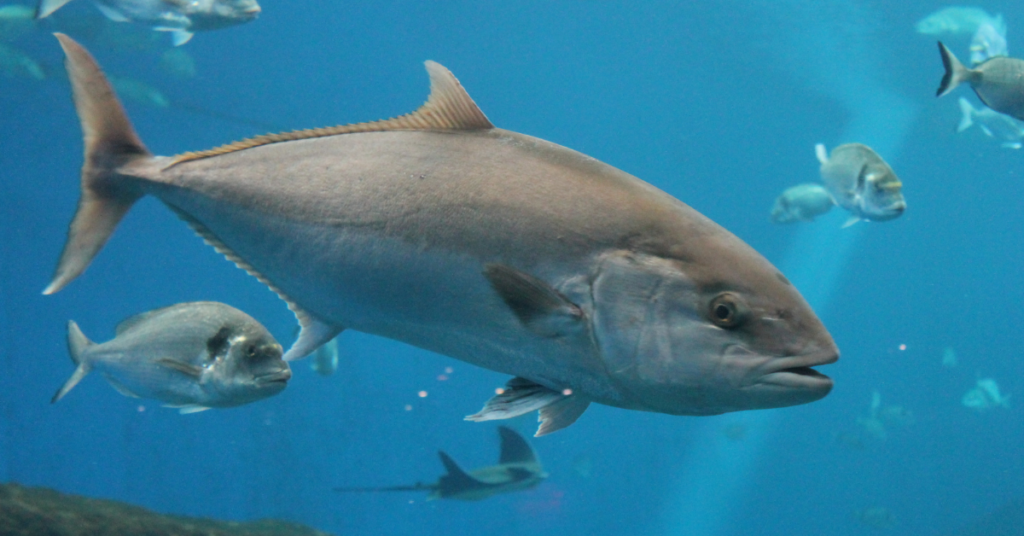Scientific name: Thunnus thynnus
Scientific classification:
Phylum: Chordata
Class: Actinopterygii
Order: Perciformes
Family: Scombridae
Description of Northern Bluefin Tuna
The pectoral fins are long and rigid and are positioned just behind the conical head, with a large mouth and eyes. The back of the fish is a deep bluish-purple and the underside is shimmering silver. The largest bluefin tuna ever recorded weighed over 750 kg and was around 3 m long.
Where does she live? This fish is found in the Atlantic Ocean and ranges throughout this expansive body of water, including temperate and tropical waters from the far north to the Mediterranean, the Black Sea, and the coasts of Brazil and West Africa.
Hydrodynamic perfection
Bluefin tuna is probably the pinnacle of fish evolution in terms of swimming ability. Its body is so well adapted to its way of life that it can cruise for thousands of miles with ease and in the pursuit of prey or escaping from danger it can accelerate to speeds more than a match for all but the fastest boats.
Such speed and power are made possible by the huge muscle mass of this fish. The whole animal is little more than a dense block of muscle. From the skeleton outwards there is layer after layer of muscle fibers which pull together to guide the sickle-shaped tail through the water in short, powerful sweeps.
Much of the tuna muscle has a limited ability to use the oxygen present in animal blood; it is anaerobic, so most of the energy is generated in the absence of oxygen. This activity in the absence of oxygen leads to the buildup of lactic acid, resulting in muscle fatigue.
A much smaller proportion of fish muscle mass is dependent on oxygen carried in the blood and is this aerobic tissue, tapering down the sides of the body to the tail, which contracts to provide the slow, steady action required for long-distance cruising.
Both of these muscle groups channel their straining effort through a pair of tendons anchored to the sickle-shaped tail fin. With each flick of the tail, in contrast to most other fish, the whole of the body remains more or less rigid, increasing the efficiency of each stroke.
In fast and furious swims, the progress of the tuna through the water is even more enhanced by the other fins nestling in shallow depressions on its body, reducing drag. An interesting arrangement of blood vessels allows it to swim in waters cold enough to discourage other fish.
The effort of the animal’s muscles generates a large amount of heat and this heat is captured by a heat exchange system where it is passed to cold blood traveling to the central nervous system and eyes, keeping them responsive even in chilly, temperate waters. This is a huge plus for bluefin tuna because it allows the animal to hunt effectively in waters, normally the reserve of warm-blooded creatures, such as marine mammals.
Facts about Northern Bluefin Tuna
• In addition to northern bluefin tuna, the world’s oceans are also home to southern bluefin tuna and Pacific bluefin tuna. There are nine other species of tuna, all of which have a similar appearance to bluefin tuna but are noticeably smaller. All the tuna and their relatives, the mackerels and bonitos are carnivores adept at using their great bursts of speed to capture prey.
• The heat exchange system of the bluefin tuna enables it to hunt as far north as the cold waters off Newfoundland.
• Bluefin tuna competes with a few other species for the fastest crown of fish. There is the sailfish and the marlin, both of which are reputed to reach speeds of 100+ kmhi short bursts.
• Tuna gills are ventilated by the fast-flowing water that surrounds them as the animals swim. Tagged individuals have been tracked from the East Atlantic to the West Atlantic and back again in one year and it is very likely they cover even greater distances. During their ceaseless oceanic wanderings, they tend to stay quite near the surface but they dive to depths of almost 1,000 m to hunt.
• The tuna has small deposits of magnetite in its head and these are thought to act as a built-in compass, allowing fish to orient themselves in the vastness of the open ocean.
• Bluefin tuna grows quite slowly. can live at least 30 years.
• The large size of the tuna and the quality of the flesh has made it a favorite of fishermen everywhere. The bluefin tuna, with its enormous size, is the most coveted of these fish and unfortunately today it is the rarest species.
Before 1970, the bluefin tuna was not held in high esteem. Captured specimens were normally returned for use in pet food. Then, the species rapidly gained a following in Japan as something of a delicacy. A large fishery grew and today stocks are severely depleted to the extent where fine examples now command huge prices.
A 200 kg specimen sold in 2001 fetched over $173,000. They span thousands of square miles of open ocean, and in many cases, longline fishing is the weapon of choice. Longlining consists of paying up to 130 km of line bristling with thousands of hooks and has many negative effects.

Erzsebet Frey (Eli Frey) is an ecologist and online entrepreneur with a Master of Science in Ecology from the University of Belgrade. Originally from Serbia, she has lived in Sri Lanka since 2017. Eli has worked internationally in countries like Oman, Brazil, Germany, and Sri Lanka. In 2018, she expanded into SEO and blogging, completing courses from UC Davis and Edinburgh. Eli has founded multiple websites focused on biology, ecology, environmental science, sustainable and simple living, and outdoor activities. She enjoys creating nature and simple living videos on YouTube and participates in speleology, diving, and hiking.

